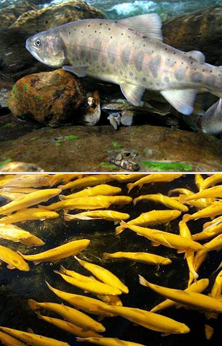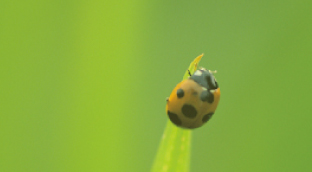|
 |
Probiotics in Fish Farming - Evaluation of a Candidate Bacterial Mixture
By Ashraf Ali, Dept. of Wildlife, Fish and Environmental Studies, SLU (2000)
The study focused on the effects of bacterial mixture administration on survival and growth of Arctic charr. The study was included two experiments which were carried out in a tap-water experimental facility and brackish water facility respectively. Two separate methods were used to treat one year old Arctic charr with a bacterial mixture (Add-B). In experiment 1, the fish were challenged with a single dose of different concentrations (0 ppm, 4 ppm, 64 ppm and 256 ppm) for 24 hours to determine a safe dose of Add-B. During the 24 hours of challenge, the experimental aquaria were maintained with well-aerated stagnant tap water. After 24 hours, all survivors were transferred into common observation tanks with a flow-through water system for two weeks. The highest mortality (11.1%) occurred in the fish groups treated with 256 ppm of bacterial mixture, whereas no mortality was found in the control group at the end of the 24 hours. Some mortality (4.4 and 2.2%) was also observed in the fish groups subjected to 4 ppm and 64 ppm concentrations respectively during 24 hours. However, these mortalities were not statistically significant from those of controls. No significant differences in mortality were found between the various treatments during the two-week post treatment period.
|
|
 |
In a second experiment, fish were treated with an intermediate concentration (64 ppm) Add-B for 6 weeks in order to study the long-term effects on survival and growth performance. The experimental set-up was based on three different treatment groups: untreated controls groups and 2 groups treated with Add-B at a concentration of 64 ppm added fortnightly and bi-weekly. Each group consisted of 5 replicate aquaria with 10 fish each. The experimental aquaria were maintained with flow-through brackish water at a constant flow rate of 0.5 l/min. Survival, specific growth rate and the development of a bacterial content of the tank water was recorded. No mortalities were recorded during the experiment. The highest growth rate was noted in fish groups treated with Add-B biweekly. This treatment group increased in mean weight from 10.1 to 15.5 g with an average growth rate of 0.90% per day. This was significantly better than the control group which grew from 10.2 to 14.3 g with an average of 0.75% per day. The fish group treated every second week (fortnightly) had a growth rate intermediate between controls and bi-weekly treated fish. The bacterial content in the water, expressed as the total cell 12 counts (TCC), was found to be significantly higher in the tanks of the two treatments when compared to the levels in control tanks. The bacterial level was significantly higher in the tanks treated bi-weekly compared to the tanks treated fort-nightly.
CONCLUSIONS AND SUGGESTIONS
The use of probiotics in fish farming shows signs of becoming a success. However, a great deal of research is still needed to certify this. One important unanswered question is the destiny of probiotic candidates in the rearing medium, on the skin and in the gastrointestinal tract of the fish. Secondly, there is an urgent need for further studies to determine the best method of administration and dosage level. Improved storage time is also required since the probiotic bacteria will have to be alive. On the basis of my results, some generalisations can be made:
1. The literature provides evidence that certain types of microorganisms have the capacity to protect fish against pathogens. Several mechanisms of action could account for the beneficial effects to fish. Among these mechanisms include production of antimicrobial substances, adhesion to the mucus, nutrient depletion and immunostimulation.
2. The administration of Add-B to water containing Arctic charr at concentrations of 64 ppm or lower was found to be safe dose.
3. Add-B can be recommended in fish farming to improve production since it enhances the growth rate of charr.
4. Add-B has the ability to increase the population level of lactic acid bacteria (LAB) in the fish intestine and may inhibit the growth of Aeromonas spp.
5. Add-B appears to increase the survival of Rainbow trout challenged with Aeromonas salmonicida.
6. There are indications that Add-B bacteria adheres to fish mucus in vitro, and thus has the capacity to colonise the fish. However, this needs futher study.
|
| |
 |
 |
|
|









